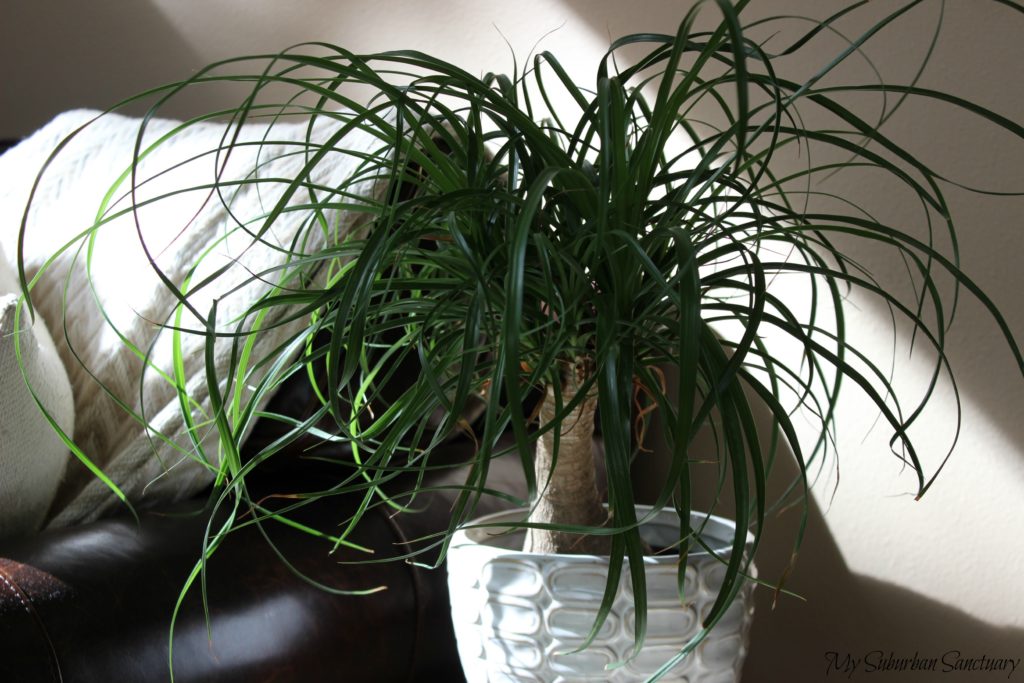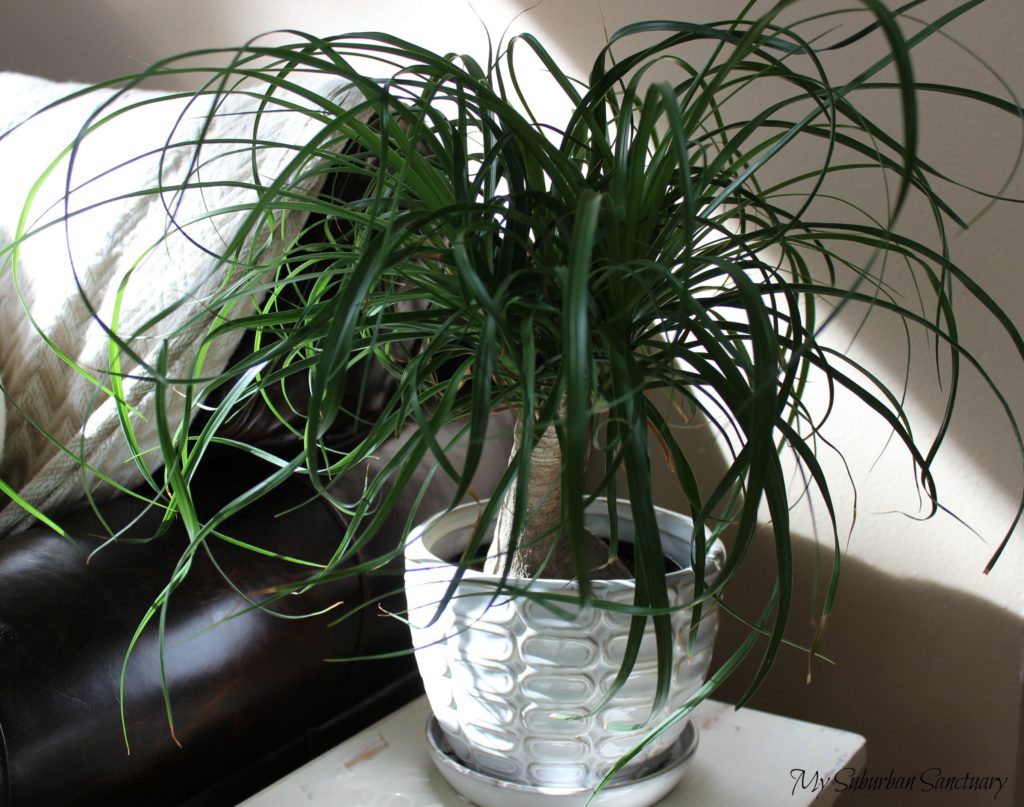

Part 2 of the (almost) goof proof plant series introduces the Ponytail Palm, “Beaucarnea Recurvata”. Not really a palm at all, Ponytails are members of the Lilacea (Lily) family and are also known as “Elephant Foot Palm” or sometimes “Bottle Palm”. True to its common name, the leaves of the ponytail sprout from the top of the plant and it looks much like the ponytail I sport on the top of my head while doing chores…. only prettier. The elephant foot reference is because its trunk ends in a textured, almost wrinkled looking bulb, similar to an elephant’s foot, where water is stored. It thrives in warm, dry soil locations and likes bright light. In its native Mexico it can grow to almost 20 feet outdoors but is easily kept to a mature size of about three feet indoors. Although it likes warmth, it can take lower temperatures in winter. (50 degrees is about the limit to keep it thriving.)
Ponytail Palm is one of my favorites for a few reasons; 1) It’s beautiful. The weeping growth that occurs as the plant gets older is lovely 2) it’s slow growing which means I don’t have to replace it frequently with a smaller plant as I do some that have fast growth rate. 3) It can be pruned to keep it small. And 4) It’s low maintenance and forgiving of benign neglect. Yay. I don’t have to nurture, baby or otherwise worry about it, I’m into benign neglect. I don’t like fussy and needy plants.

As usual, there are some growing tips:
Ponytails like being somewhat root bound. No need to re-pot unless the roots have broken through your plastic pot. Which happens, so use a clay or glazed pot. (I keep mine in the plastic nursery pot it came in for ease of watering, but I hide it with a pretty glazed pot.) If you decide to re-pot, use a pot that’s only an inch or so bigger around as well as deeper. Use a fast draining soil, cactus soil mixes are ideal.
Water only when the soil is dry and water deeply, then leave it alone for at least a week, sometimes longer. I water mine about once a month. I submerge the whole plant, plastic pot and all, in a bucket of water for less than a minute, a few seconds really. Then I let it drain and pop the whole thing back in its pretty glazed pot. This technique means I don’t have to guess or worry about over watering in the glazed pot. I can see the water draining out of the plastic nursery pot it came in and once drained it goes back in its glazed container, plastic pot as well. Always check the soil of any plant before watering! If you read Part 1 of the plant series on the blog, you’ll already know the technical term and tool to use to check the soil to see if it needs watered. Your finger. In the pot. As in, stick your finger in the soil to about an inch. If it’s dry, water, if it’s moist don’t. Truly I am a master of of all things technical. Mist your plant once a week or so to increase humidity if your house, like mine, is dry from air conditioning in the summer or heat during winter.
Bright light is a must. So put it somewhere where it will get several hours of sunlight everyday. Fertilize only twice a year during the growing season (in summer for most of us) with a 50/50 mix of liquid fertilizer and water.
TROUBLE SHOOTING:
PESTS. Although it’s usually pest free, the Ponytail does sometimes become a victim of either scale or spider mites. Scale look like waxy bumps on the leaves of the plant. Spider mites are tiny little red insects that will leave small telltale webs on the leaves. A light spray of insecticidal soap or application of neem oil will control both. Dead scale are easily removed by scraping them off the leaves with your fingernail. Use a damp cotton swab to remove the webs of spider mites.
YELLOW LEAVES. Too much water will result in yellow leaves and a soft trunk bulb and shaft. Check to see if your plant’s roots are rotting or if the soil smells bad. If so, remove it from the pot, let the plant completely dry out, clean your pot and sterilize with a weak solution of bleach and water, rinse it well, dry it, and use new soil. Replant and water once. Then begin again, monitoring your water use.
SHRIVELED BROWN LEAVES, or a desiccated (dried and shriveled) trunk means you aren’t watering enough. Soak the plant for a few minutes in room temperature water and let drain. Water more often, but check the soil to make sure you don’t over water.
BROWN LEAF TIPS. Severe browning of leaf tips or entire leaves is generally due to not enough water or lack of humidity or 2) Too much fertilizer, too often, or 3) water that is chlorinated or has excess minerals. If you have treated (city or county) water and brown leaf tips, switch to spring water and mist your leaves to increase humidity. 4) Brown tips can also occur as a matter of age. Trim the brown tips off, once brown they will never be green again. Use a dedicated pair of shearing/pruning shears. Clean your shears with alcohol after using. You can see that there are a few brown tips on the leaves in my pictures, and if you look closely you’ll see one or two small dead, brown leaves. This is normal. I haven’t trimmed the tips of my plants since last spring. Because I’m lazy. I might trim them in time for our annual Super Bowl party. So that everyone can admire how pretty it is and marvel at my plant parenting skills. Probably not, I’ll be tired from cleaning my baseboards so that everyone can marvel at my housekeeping skills instead. I mean, I have my priorities.

Give the Ponytail Palm a try, it’s a beautiful, graceful plant that you can enjoy for years. It adds life to any space and really isn’t fussy. It’s almost goof proof.
Waaaaah thanks so much for this post! There is definitely something wrong with my plants.
If you repot, does that mean you have to get all new soil or just take the root-bound clump and add more cactus soil?
2 Comments